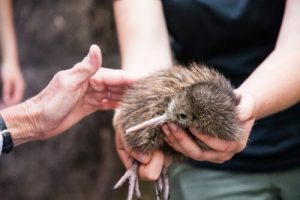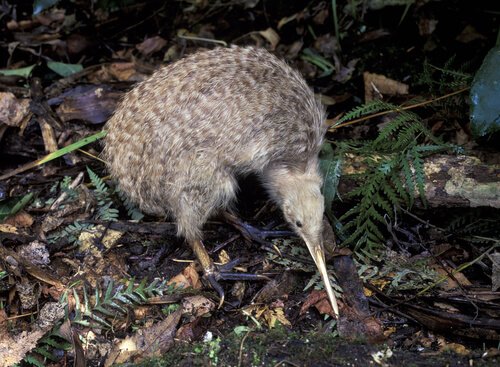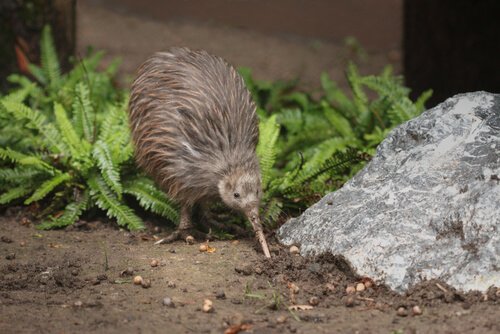The Kiwi Has Been Rescued From Extinction

The kiwi is one of the most peculiar birds on the planet for various reasons. At the same time, it is one of the cutest birds due to their unique appearance. Unfortunately, English colonists hunted this animal as a trophy throughout the nineteenth and twentieth centuries. Fortunately, today the kiwi has made a comeback after nearly going extinct.
A unique island
As mentioned above, this bird is one of the symbols of New Zealand, a small country in Oceania. New Zealand is well-known worldwide due to the filming of the movie the Lord of the Rings.
However, the curiosities of this country don’t end there. There is an estimate of there being more sheep living on the island than people. However, there’s nothing that stands out more about this country than its strange wildlife.
Due to this country being isolated from most of the world, there is a lot of amazing wildlife on the island that’s unique in comparison to the rest of the word. The reason why these animals are so unique maybe because they haven’t been changed for many years.
Such is the case of the kiwi, a medium-sized bird with a very particular shape. It has an oval-shaped body, elongated beak, no visible wings, large legs, no tail, and feathers that are similar to hair. They also have an atrophied claw in the location where their wings should be.

The national bird of New Zealand
There are five species of kiwis living in different areas on the island: Brown, Rowi, Tokeoka, Roroa, and Mottled Dwarf. Each of these species is endangered due to the loss of their natural habitats. Not only that, but predators and hunting have made the number of these birds drop.
Kiwis are nocturnal animals and omnivores. Their favorite food is insects. During the day, they usually hide from their natural predator — the ermine — inside burrows under the ground. One fact about kiwi is that they have one of the most developed senses of smell among birds.
Also, kiwis can lay eggs as large as their bodies. Sometimes the egg is so big inside the female that she can’t eat since it takes up all the space in her tiny body.
These birds need more time to hatch their eggs, which is an advantage and disadvantage at the same time. While the population won’t increase that much, chicks are more capable of defending themselves once they hatch.
The situation with the kiwis is so serious that scientists believe that in the 90s there were only 200 birds left. At present, there is an estimation of 68,000 birds living on the island. Unfortunately, 2% of these birds end up missing each year, about 20 birds per week on average.

Despite the current situation with its habitat, several organizations in New Zealand claim that the kiwi has been rescued from extinction. This is thanks to education about these birds, supported by the government.
How the kiwi was rescued from extinction
Since its the national bird of New Zealand, many people are concerned about their population. Hunting them is illegal, and their population is constantly monitored. Even the indigenous people, the Maori, consider this animal sacred and they are protected by the forest god.
Conservation and educational groups have raised awareness about taking care of these birds. Otorohanga Kiwi House and Kiwis for Kiwi are two of the organizations that are dedicated to saving these birds.
The Department of Conservation (DOC) in New Zealand also has a program for rescuing kiwis. Their objective is to control the number of predators in their habitats and monitor individual birds. They also seek to increase the number of genes available.

Programs dedicated to taking care of kiwis
Since 2000, the DOC has designated several sanctuaries where kiwis can live in peace. There are three on the Northern Island and two on the Southern Island.
- Whangarei Kiwi Sanctuary
- Moehau Kiwi Sanctuary
- Tongariro Forest Kiwi Sanctuary
- Okarito Kiwi Sanctuary
- Haast Tokoeka Kiwi Sanctuary
Apart from preserving the lives of these animals, these sanctuaries are meant to run other programs that the DOC controls with several organizations.
For example, Operation Nest Egg is a program that recovers these birds’ eggs to raise them in captivity up to a certain age. Once the chicks can defend themselves on their own, they are released into one of the sanctuaries.
Due to these programs, we can now say that the kiwi has been rescued, or at least is in the process of recovery. However, everyone must do their part to make sure this animal doesn’t become endangered again.
The kiwi is one of the most peculiar birds on the planet for various reasons. At the same time, it is one of the cutest birds due to their unique appearance. Unfortunately, English colonists hunted this animal as a trophy throughout the nineteenth and twentieth centuries. Fortunately, today the kiwi has made a comeback after nearly going extinct.
A unique island
As mentioned above, this bird is one of the symbols of New Zealand, a small country in Oceania. New Zealand is well-known worldwide due to the filming of the movie the Lord of the Rings.
However, the curiosities of this country don’t end there. There is an estimate of there being more sheep living on the island than people. However, there’s nothing that stands out more about this country than its strange wildlife.
Due to this country being isolated from most of the world, there is a lot of amazing wildlife on the island that’s unique in comparison to the rest of the word. The reason why these animals are so unique maybe because they haven’t been changed for many years.
Such is the case of the kiwi, a medium-sized bird with a very particular shape. It has an oval-shaped body, elongated beak, no visible wings, large legs, no tail, and feathers that are similar to hair. They also have an atrophied claw in the location where their wings should be.

The national bird of New Zealand
There are five species of kiwis living in different areas on the island: Brown, Rowi, Tokeoka, Roroa, and Mottled Dwarf. Each of these species is endangered due to the loss of their natural habitats. Not only that, but predators and hunting have made the number of these birds drop.
Kiwis are nocturnal animals and omnivores. Their favorite food is insects. During the day, they usually hide from their natural predator — the ermine — inside burrows under the ground. One fact about kiwi is that they have one of the most developed senses of smell among birds.
Also, kiwis can lay eggs as large as their bodies. Sometimes the egg is so big inside the female that she can’t eat since it takes up all the space in her tiny body.
These birds need more time to hatch their eggs, which is an advantage and disadvantage at the same time. While the population won’t increase that much, chicks are more capable of defending themselves once they hatch.
The situation with the kiwis is so serious that scientists believe that in the 90s there were only 200 birds left. At present, there is an estimation of 68,000 birds living on the island. Unfortunately, 2% of these birds end up missing each year, about 20 birds per week on average.

Despite the current situation with its habitat, several organizations in New Zealand claim that the kiwi has been rescued from extinction. This is thanks to education about these birds, supported by the government.
How the kiwi was rescued from extinction
Since its the national bird of New Zealand, many people are concerned about their population. Hunting them is illegal, and their population is constantly monitored. Even the indigenous people, the Maori, consider this animal sacred and they are protected by the forest god.
Conservation and educational groups have raised awareness about taking care of these birds. Otorohanga Kiwi House and Kiwis for Kiwi are two of the organizations that are dedicated to saving these birds.
The Department of Conservation (DOC) in New Zealand also has a program for rescuing kiwis. Their objective is to control the number of predators in their habitats and monitor individual birds. They also seek to increase the number of genes available.

Programs dedicated to taking care of kiwis
Since 2000, the DOC has designated several sanctuaries where kiwis can live in peace. There are three on the Northern Island and two on the Southern Island.
- Whangarei Kiwi Sanctuary
- Moehau Kiwi Sanctuary
- Tongariro Forest Kiwi Sanctuary
- Okarito Kiwi Sanctuary
- Haast Tokoeka Kiwi Sanctuary
Apart from preserving the lives of these animals, these sanctuaries are meant to run other programs that the DOC controls with several organizations.
For example, Operation Nest Egg is a program that recovers these birds’ eggs to raise them in captivity up to a certain age. Once the chicks can defend themselves on their own, they are released into one of the sanctuaries.
Due to these programs, we can now say that the kiwi has been rescued, or at least is in the process of recovery. However, everyone must do their part to make sure this animal doesn’t become endangered again.
This text is provided for informational purposes only and does not replace consultation with a professional. If in doubt, consult your specialist.







